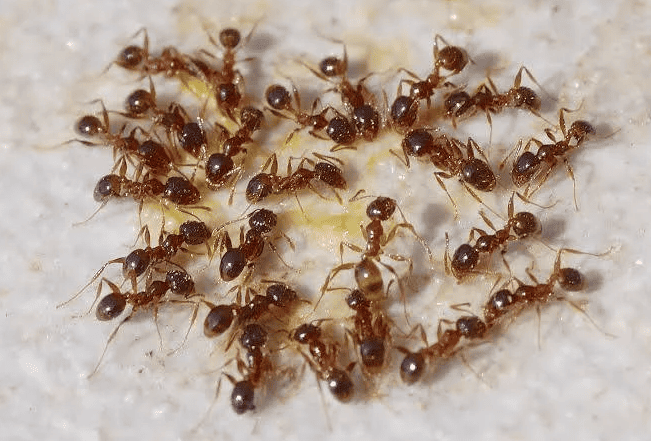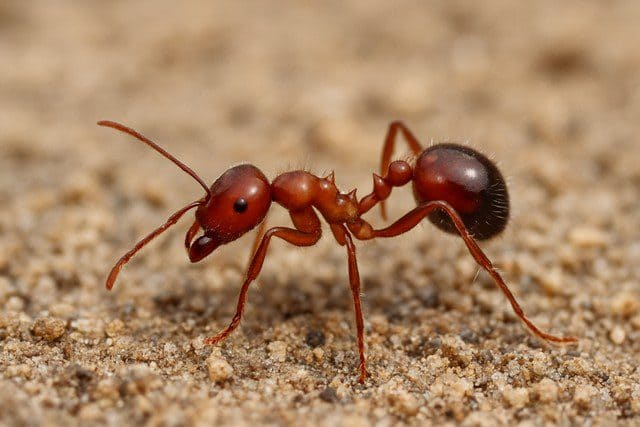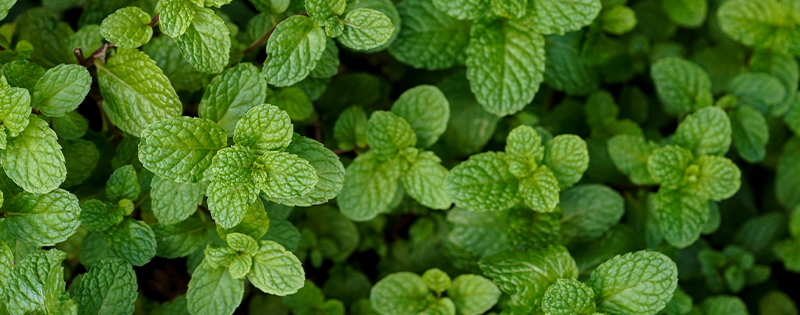Have ants invaded your home? Gardens, terraces, kitchens, etc. These little insects can sometimes be invasive. First and foremost, you need to find their nest in order to get rid of them. Here are our tips for quickly finding an anthill and the right steps to take.
Key takeaways
➡️ An ant nest (or anthill) is a complex structure housing thousands of individuals, organised around a queen, workers and larvae.
➡️To locate it, look for regular lines of ants, small mounds of earth, or entry points in walls, skirting boards or planters.
➡️ Action must be taken if the nest is inside the house or if it is an invasive species (pharaoh ants, electric ants, etc.).
➡️Natural methods (vinegar, bicarbonate of soda, diatomaceous earth, etc.) are often sufficient to eliminate a small colony.
➡️In the event of a major infestation, opt for a professional treatment approved by Certibiocide.
Ant nest: a veritable miniature city
When you look closely, an anthill is a small society where each insect plays a specific role. Ants live, reproduce, store food and raise their larvae in a perfectly organised system.

Did you know?
An ant nest is home to several castes:
- The queen, the only reproductive member, sometimes lays several thousand eggs per year.
- The workers, which are sterile, take care of transport, food and nest maintenance.
- The larvae and eggs, which grow in protected, ventilated chambers.
- The soldiers, or more robust ants, are responsible for defending the colony.
Some species, particularly Myrmicinae such as the red ant, can have several queens and several thousand individuals.
The nest then functions as an interconnected colony, with dedicated areas: larval chambers, food reserves, circulation tunnels, and ventilation outlets.
Where do ants build their nests?
Ants adapt their environment according to climate, humidity and available food.
- In nature: under stones, in the ground, roots or dead tree trunks.
- In houses: in hollow walls, behind skirting boards, under floors, or near electrical conduits.
- Some species, such as carpenter ants, dig into wood, sometimes causing damage comparable to that caused by termites.
These nests can contain from a few hundred to several hundred thousand individuals, connected by complex tunnels that can extend for several metres.
The main species of ants and their types of nests
| Ant species | Appearance/size | Location of the nest | Risks |
| Black garden ant (Lasius niger) | Black, 3 to 5 mm | Lawn edging, pavement cracks, exterior walls | A very common species, often enters houses in search of crumbs. |
| Red ant (Myrmica rubra) | Brownish red, 4 to 6 mm | Wetlands, meadows, forest edges | Stings when the nest is disturbed, can invade gardens. |
| Carpenter ant (Camponotus ligniperda) | Black or brown, 6 to 12 mm | Roof structures, floors, joinery | Damages wooden structures, often mistaken for termites. |
| Argentine ant (Linepithema humile) | Light to dark brown, 2 to 3 mm | Urban areas, kitchens, walls, basements | Invasive species, difficult to eradicate; no single queen. |
| Pharaoh ant (Monomorium pharaonis) | Light yellow, 2 mm | Heated interiors: hospitals, buildings, kitchens | Feared for its ability to colonise buildings; can contaminate food. |
| Electric ant (Wasmannia auropunctata) | Orange-brown, 1.5 mm | Sockets, electrical boxes, dry wood | Painful sting, may cause short circuits; invasive species. |
How can you recognise an ant nest?
Outdoors (garden, patio, lawn)
- Small mounds of earth or sand: often visible between paving slabs, along borders or around roots.
- Well-defined ant trails: workers move in single file between the food source and the nest.
- Digged soil: a sign of active underground tunnels.
- Frequent visits to the same spot, especially at sunrise or sunset.
- Piles of twigs, leaves or soil forming a dome (typical of red ants).
- Presence of fallen wings on the ground, indicating the departure or establishment of a new colony.


Inside (house, flat)
An ant nest is home to several castes:
- Ants visible around crumbs, rubbish bins or pet bowls.
- Regular trails near skirting boards, cracks or electrical conduits.
- Ants present at night: they are more active at this time.
- Small particles of wood or dust at the foot of walls or furniture (sign of a carpenter ant nest).
- Practical tip: Place a drop of honey and observe the direction in which the workers return; this will lead you to the anthill.
Should you always get rid of an ant nest?
Before considering destroying a nest, it is important to remember that ants play a very important ecological role.
In gardens and natural areas, these insects contribute to the balance of the ecosystem.
- They aerate the soil with their tunnels.
- They eat other harmful insects such as larvae, scale insects and fleas.
- They help disperse seeds, which is useful for certain flowers and plants.
In myrmecology (the science that studies ants), they are considered bioindicators of the health of an ecosystem.
When should you get rid of an ant nest?
1. If the nest is inside the house
A nest built into the walls, under the floor or behind the skirting boards can cause problems. Some species, such as carpenter ants (Camponotus ligniperda), dig into the wood and weaken the structure of the house, much like termites. There are also electric ants, an invasive species that settles in electrical sockets, household appliances and wooden structures, sometimes causing short circuits.


2. If the nest threatens the garden or animals
A nest can become a nuisance when:
- The ants attack plants to protect the aphids they are raising.
- They settle near feeders, chicken coops or animal bowls, attracted by food.
- They dig under patio slabs or paving stones, causing the ground to lift.
3. If they are invasive species
Some species are not content with a small territory; they attack other insects and upset the balance of biodiversity. They can also deliver very painful bites to humans.
| Species | Features | Risks |
| Red ant (Myrmica rubra) | Brownish red, 4 to 6 mm, lives in dense colonies in damp areas. | Aggressive species that stings repeatedly; can invade gardens and cause painful skin reactions. |
| Argentine ant (Linepithema humile) | Light brown, highly mobile, multiple colonies without a single queen. | Rapid colonisation of kitchens and gardens, difficult to eradicate, resistant to many insecticides. |
| Pharaoh ant (Monomorium pharaonis) | Pale yellow, tiny (2 mm), likes warmth. | Infest buildings, hospitals, communal kitchens; carries bacteria and germs. |
| Electric ant (Wasmannia auropunctata) | Orange-brown, very small (1.5 mm). | Painful sting, risk of short circuits (nests in electrical appliances). |
| Fire ant (Solenopsis invicta) | Dark red, aggressive and venomous. | Multiple stings and allergic reactions, rapid colonisation, local ecological destruction. |
Good to know: if you spot invasive ants near your home, notify your local council. You will need to call in a licensed professional exterminator.
How to get rid of an ant nest?
Natural methods
Before using chemicals that can be harmful to the environment and other animals, it is best to start with natural methods.
White vinegar
A classic remedy for repelling ants.
Mix equal parts white vinegar and water in a spray bottle, then spray on trails, skirting boards and entrances to the nest.
➡️ The acidic smell masks the trail pheromones that ants use to find their way around.


Lemon
Its acidity acts as a natural repellent. Squeeze a lemon and place pieces or juice directly at the entrance to the nest.
➡️ Repeat every two days.
Baking soda
When mixed with powdered sugar, it attracts ants while causing a fatal internal reaction when they ingest it.
➡️ Place small bowls of the mixture (50/50) in areas where ants are frequently seen.


Diatomaceous earth
This 100% natural mineral powder works mechanically by cutting through the thin protective layer of ants. Use biocidal diatomaceous earth that is uncalcined, amorphous, and has a minimum silica (SiO2) content of 90% for greater safety and effectiveness.
➡️ Sprinkle or spray around the nest, under skirting boards, or near kitchen openings.
See also: Diatomaceous earth: an effective solution against bed bugs.
Repellent plants
Certain plant scents strongly repel ants:
- Peppermint
- Lavender
- Cinnamon or cloves
➡️ Place a few dried leaves or drops of essential oils in areas where ants tend to travel (window sills, skirting boards, balconies)..


Clean your home regularly
This is the simplest and most effective thing you can do:
- Avoid leaving crumbs, sweet leftovers or pet food bowls uncovered.
- Clean surfaces with soapy water or vinegar.
- Empty and disinfect bins regularly.
Professional treatments
Chemicals should only be used as a last resort and never without precautions.
Any professional who uses insecticide products must hold a valid Certibiocide certificate issued by the Ministry of Ecological Transition.
Verification of a Certibiocide certificate
Pest control companies often work in two stages:
- Precise diagnosis: identification of the species and location of the nest.
- Appropriate treatment: application of a gel, insecticide or specific bait.
Some professionals also offer post-treatment monitoring to ensure that the colonies have been completely eradicated.

